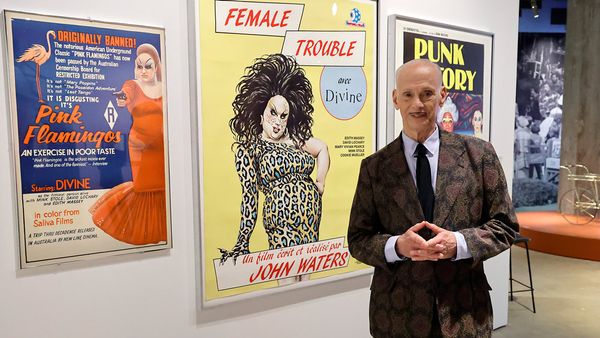
May 21, 2017
Dorothea Lange's Unswerving Eye
Sura Wood READ TIME: 4 MIN.
The career of Dorothea Lange, the influential photographer who created some of the most iconic bodies of work of the 20th century, took a substantially different turn on a fateful day in 1933, when she stepped out of her thriving San Francisco portraiture studio onto the streets and shot her first documentary photograph, "White Angel Bread Line." The now-famous image chronicled the spectacle of a hungry, dejected man with his back to a rowdy crowd outside a soup kitchen near Filbert Street, one of many similar scenes playing out in the city at a time when the Depression was cutting deep. For Lange, who was around 40, the episode marked an awakening to suffering in the wider world, and to the possibilities of using a camera to make an important statement about society. "Lange is someone who literally found her purpose in life one afternoon," said Drew Johnson, curator of "Dorothea Lange: Politics of Seeing," a new exhibition at the Oakland Museum of California that examines the photographer's work in the context of the critical socio-political issues of her time.
Among the 130 photographs on view are rare portraits of the artist that reveal the formidable woman whom friends and family nicknamed "Dictator Dot," including one taken shortly before her death in 1965 by Ansel Adams, with whom she had a complicated relationship. One also gets a taste of her range in unfamiliar works such "Little Man, Stepping Off a Cable Car" (1956), which appeared on the cover of Aperture magazine in 1950. With its ethereality, odd perspective and a disembarking passenger who might as well be stepping off the edge of the world, it's the kind of picture Garry Winogrand could have taken years later.
With access to Lange's archive of more than 6,000 prints and 25,000 negatives, which was gifted to the museum nearly 50 years ago (she was based in Berkeley from the 1930s onward), it must have been tempting to pack the show to the brim, but Johnson, attuned to the danger of exhausting viewers, has been selective to the point of leaving some of those same viewers hungering for more. One minor caveat: the decision to exhibit work by several Lange inheritors. However deserving, they take space that otherwise could have been allocated to Lange, who doesn't come close to wearing out her welcome in this exhibition. Aside from some brief explanatory paragraphs and a peppering of quotes from the artist, Johnson wisely lets the pictures speak for themselves, and they have a lot to say. Lange's greatest gift was her ability to humanize her subjects. Whether they were beaten down and defeated by the Great Depression; migrants and farm families fleeing the devastation of the Dust Bowl; targets of pervasive racism in the deep South; or traumatized Japanese Americans, rounded up, forcibly displaced and shipped to internment camps during World War II, she had an unerring instinct for the small, telling, often heart-wrenching detail. In "Mended Stockings" (1934), for example, the crossed legs of a seated woman direct our attention to her hose, whose prominent, hand-stitched seams hint at her reduced circumstances. The ignominy of death for the poor lands like a punch to the gut in "Death in the Doorway" (1939), in which an unclaimed corpse, shot from a distance, lies at the entrance to a clapboard church in a migrant laborer shack-town.
Lange's compassion for the vulnerable was borne from her own early troubles. Her childhood was scarred by her father's abandonment of the family, and by the polio she contracted at 7 that left her with a permanent limp. She believed her disability and being "one of the walking wounded," as she put it, enabled her to establish rapport with her subjects and earn their trust. The hallmarks of her work - deep empathy and respect for the dignity, strength and the individuality of the people she photographed - were hard-won.
More than 70 years later, it remains difficult to look at her pictures of the shell-shocked Japanese Americans dispatched to internment camps during WWII. In 1942, the U.S. government hired Lange to document their so-called relocation, but given the devastating nature of her photographs, the project backfired, leading the military to seize and impound the images for the duration of the war. A plaintive sign above a Japanese grocery proclaiming, "I Am an American"; a grandmother in her Sunday best standing next to hastily packed belongings piled on the street; the unbearably bleak camp at Manzanar, a place one lives to forget, engulfed in a dust-storm; and the Stockton Assembly Center, where children wait outside barrack rooms the size of closets, are among the poignant images that memorialize a shameful chapter in American history, and still wrack the conscience.
Lange's tenure at the Farm Security Administration, which enlisted her to expose the plight of dispossessed farmers and Dust Bowl migrants, led to her most famous photograph, "Migrant Mother, Nipomo California" (1936). The stark black & white portrait of Florence Owens Thompson, a weather-beaten 32-year-old woman, whose gaunt, careworn face became the definitive image of the Depression, took on a life of its own. Several versions are included here, along with mugs, T-shirts and key chains emblazoned with Thompson's face, and newspaper articles where she expressed regret at being turned into a symbol of destitution, a perception that lingered long after her life took a turn for the better. "I didn't get anything out of it," Thompson lamented. "I wish she hadn't taken my picture."
Lange's Depression-era imagery strongly influenced John Ford's film The Grapes of Wrath and the John Steinbeck novel on which it was based. In 1965, the author sent her a handwritten letter with his crooked letterhead stamp at the top. "There have been great ones in my time," he wrote. "Surely, you are among the giants."
Lange received it three months before she died as she was preparing for a comprehensive exhibition at MoMA. She was the first woman photographer ever to be honored with a full retrospective at the museum.
Through Aug. 13. Info: museumca.org.







